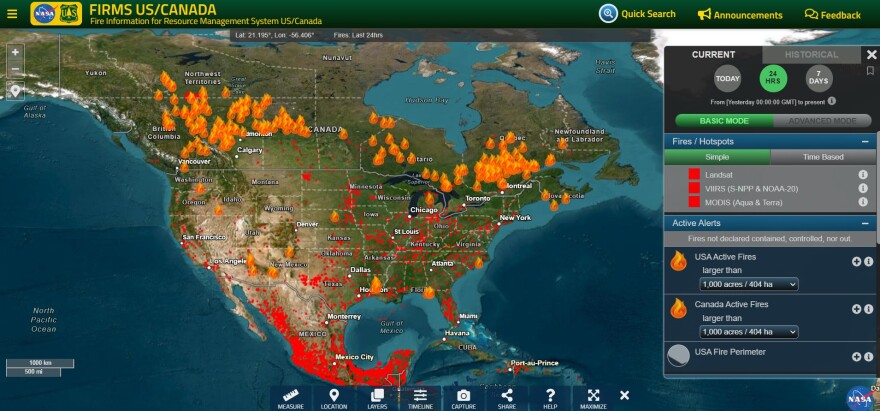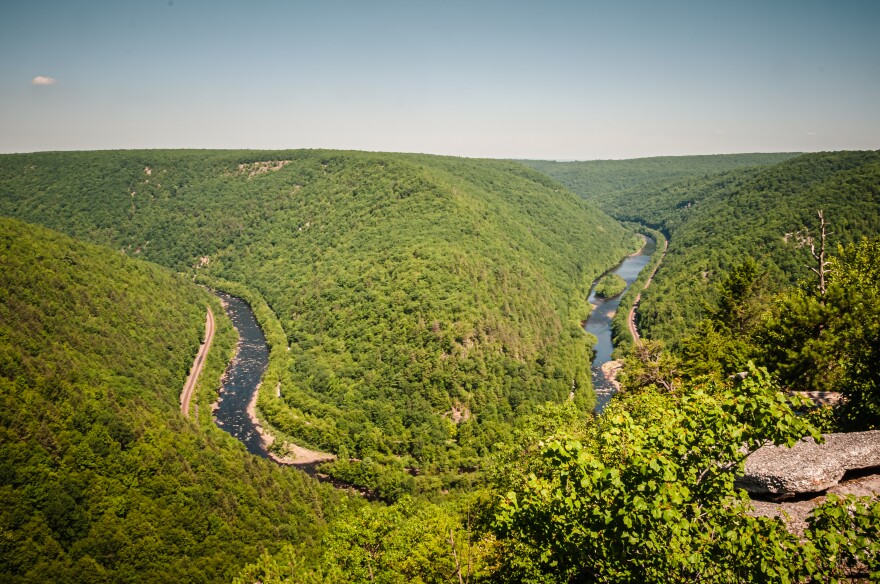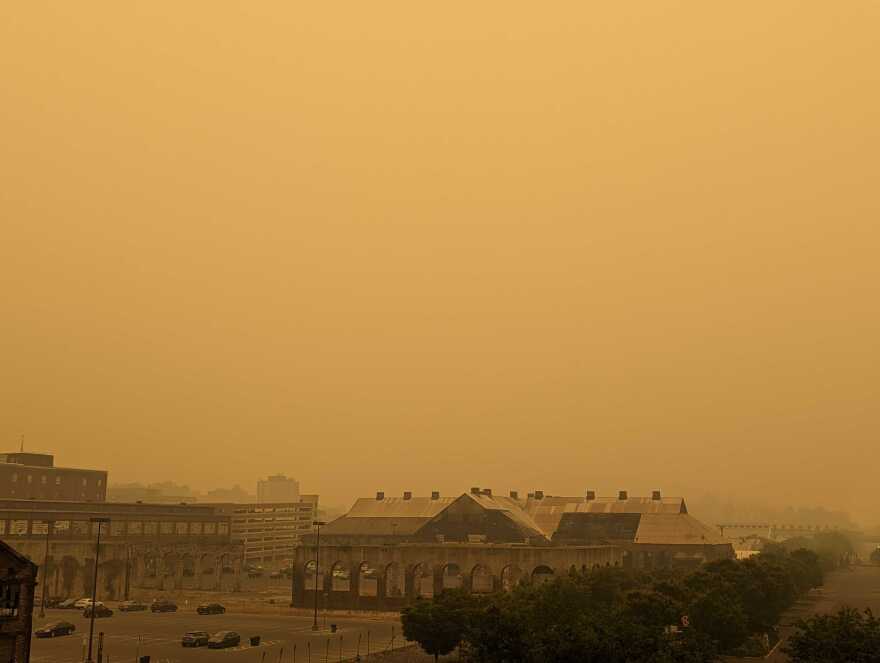BETHLEHEM, Pa. — It’s no longer a question of preparing for climate change, Stephanie Wein said — the negative impacts are already here.
Now, residents of the Lehigh Valley, and the world over, need to pivot to building up resilience.
- Intense, widespread Canadian wildfires are still burning
- Researchers are studying the effects of smoke on plants, crops and water
- As climate change fuels wildfires, smoky days may become more common in the Lehigh Valley
“We need to act as quickly and decisively as possible to limit the worst impacts of climate change and transition off the fossil fuels that are feeding this extreme weather, but a lot of those impacts we're already seeing — and so figuring out how to best understand them, and how to be most resilient to them,” said Wein, a clean water and conservation advocate with PennEnvironment. “Now, you just need to walk and chew gum at the same time."
"Because we've kicked the can down the road on tackling climate change for so long, now we're dealing with the consequences and have to figure out how to best understand and work with them."Stephanie Wein, a clean water and conservation advocate with PennEnvironment
“ ... Because we've kicked the can down the road on tackling climate change for so long, now we're dealing with the consequences and have to figure out how to best understand and work with them.”
Weeks after the Lehigh Valley turned sepia toned from Canadian wildfire smoke, the skies have cleared and there’s even been some rain, even though it hasn’t been enough to push much of the state out of moderate drought status. While environmentalists and researchers said impacts on the region’s crops and water may be few due to the short duration of smoky days, it’s a largely understudied topic.
However, as climate change worsens and the chance for more wildfires increases, experts said the impacts could similarly escalate.
A few weeks ago, the Valley had a rash of days with some of the worst air quality ever recorded after smoke from hundreds of wildfires across Canada blew into the region. As the hazy air lingered, stuck in the trough between South Mountain and Blue Mountain, residents struggled to breathe, and air purifiers were in short supply.
And wildfires aren’t a far-off problem — they’re here in the commonwealth, too.
Pennsylvania has already seen more wildfires in the first six months of 2023 than all of 2022, according to state data.
Are the wildfires still burning in Canada?
As of June 14, there were 130 fires in Canada deemed uncontrolled, according to the most recent national data. Ninety-two were being held, and 121 were being controlled.

So far this year, there have been 2,683 fires, burning 5.8 million hectares, according to the Canadian Interagency Forest Fire Centre. It's a massive increase over the 10-year average for the amount of area burned.
“Canada is at national preparedness level 5, indicating [the] full commitment of national resources is ongoing, demand for resources is extreme, and international resources are being mobilized,” according to Natural Resources Canada, a government environmental agency. “At the time of this report, aircraft, personnel and equipment have been mobilized to Alberta, Ontario, Quebec, Nova Scotia and northwest territories from across Canada.
“There are American, Australian, and New Zealand and South African personnel, crews active in Canada, with additional personnel from France, Australia and New Zealand, and South Africa anticipated.”
The Valley was spared the most recent smoke — on Wednesday, St. Paul, Minnesota, had the worst air quality in the U.S. due to ongoing Canadian wildfires, the Associated Press reported.
Residents shouldn’t see this as a “one-off” event, Wein said, even if it’s unusual.
“This isn't without precedent, in the sense that we were understanding how climate change is going to fuel this extreme weather,” she said. “And so we shouldn't see this as a one-off – we should see this as something that we want to, we need to be ready for what we want to avoid more in the future.”
How can the smoke affect the Lehigh Valley’s water?
The Valley already has its share of environmental concerns, especially with the Lehigh River, a 109-mile-long tributary of the Delaware River that flows through most of the Valley.
Two months ago, the Lehigh River was included in American Rivers’ annual list, “America’s Most Endangered Rivers,” due to the “poorly planned development” of warehouses and distribution centers.

Wildfires, and the smoke they create, can have devastating impacts on rivers and streams, as well as residential drinking water, according to the U.S. Environmental Protection Agency.
“During active burning, ash and contaminants associated with ash settle on streams, lakes and water reservoirs,” according to the agency’s website. “Vegetation that holds soil in place and retains water is burned away. In the aftermath of a large wildfire, rainstorms flush vast quantities of ash, sediment, nutrients and contaminants into streams, rivers, and downstream reservoirs.
“The absence of vegetation in the watershed can create conditions conducive to erosion and even flooding, and naturally occurring and anthropogenic substances can impact drinking water quality, discolor recreational waters and may potentially contribute to harmful algal blooms.”
What about plants and crops?
In plants and crops, wildfire impacts vary.
“The science is mixed and it is sort of a mixed bag on what smoke does to plants, both crop plants and wild plants and that the outcomes are different because smoke is a really complicated phenomenon and because plants are so different,” Wein said.
However, there are things that are able to be generalized, she explained. During heavy smoke cover, there’s decreased sunlight, which can cause plants to struggle to photosynthesize.
“Remember, plants get their energy from the sun and so folks remember on the worst smoke day last week, it was pretty dark out,” she said. “And so the plants feel that too, and they aren't able to create as much energy for themselves.”
Conversely, the light can become diffused from the smoke, which can be a good thing.
“In a forest, it can ironically mean that more light is reaching further down to plants because there aren't these harsh patches of light and dark on you're actually seeing lights sort of more scattered out,” Wein said. “And so how that plays out for different plants really depends on the need of the plant to have less sunlight.”
The effects can be “a bit nuanced,” according to researchers at the University of Minnesota Extension.
“The scale of these impacts differs between ecosystems: the uncertainty is based on ozone damage sensitivity, cloud cover and aerosol properties,” according to researchers. “There are very few studies about the impacts of wildfire smoke on crops, and they are mostly on global scales, so we can’t translate this directly to say how much these wildfires will impact vegetable growth.”
What, if any, are the long-term impacts?
Because there were only two or three days of smoke in the Valley, it’s hard to say if there will be lasting impacts, Wein said. However, with the fires still burning, there’s a chance the region could see more smoke this summer.
“If we don't see more days like that — if you're socked in with smoke for weeks like we've seen in California in previous years, then it really can expect to have a bigger impact than just a few days like we had last week,” she said. “But we also know that the Canadian government and the Quebecois government are saying that there's not necessarily an end in sight for these fires, that they're burning well beyond the capacity of the firefighting crew they have on the ground to put them out and the dry conditions may continue.
“And so depending on the wind patterns, we might see throughout the summer more smoke days, and so whether or not this was an isolated incident will play into how big an impact smoke has on both crop plants and wild plants long term.”


